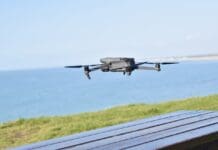This post is also available in:
 עברית (Hebrew)
עברית (Hebrew)

The Israeli UAS industry is facing fast growing competition.
A new unmanned air systems (UAS) developer and integrator is making its U.S. debut at the Association for Unmanned Vehicle Systems International annual conference in Washington this week.
Unmanned Systems Group (USG), headquartered in Switzerland with engineering facilities in Sweden and a large contingent of Saab veterans in its workforce, is presenting two fixed-wing UAS and a one-third-scale model of a rotary-wing system that revives and improves on a long-neglected propulsion technology.
According to Aviation Week a key feature of USG’s systems is that they are “ITAR-free” — they have no U.S. components and thus are not affected by U.S. State Department International Traffic in Arms Regulations. Key markets are in nations that prefer not to acquire systems from the U.S. nor Israel.
The larger, fixed-wing UAS is the Discoverer II, which CEO Michael Olofsson says is unique in being designed around its payload: the Selex ES Seaspray 5000E radar, primarily used for maritime surveillance. (Selex’s PicoSAR is an option for overland missions.) As a result, the small aircraft (550-lb. takeoff weight) can offer an endurance of up to 16 hr. with full littoral and blue-water capability. It is being offered with alternative gasoline and heavy-fuel engines. The aircraft on display at AUVSI is the second flight-test article.

The smaller (47-lb. launch weight) Discoverer I is designed to fill the gap between backpack UAS and larger, tactical vehicles, with a complete system being compact enough to fit on a light truck or SUV. The company offers a car-top launcher that attaches to a commercial Thule roof-rack system. It incorporates an electric starter and automatically releases the aircraft at speeds as low as 70 km/hr.
The Atro-X rotary-wing UAS is also designed to carry Seaspray 5000E. It is larger than rivals such as the Saab Skeldar and Schiebel CamCopter, with a 20-ft. rotor diameter, and is powered by a simple jet engine, mounted vertically above the rotor head and delivering hot gas to tip-jet exhausts. (Hot-cycle tip jets were tested experimentally in the 1950s and 1960s, along with tip-mounted ramjets and systems that used cold, compressed air with rotor-tip burners.) Olofsson notes that the system is light, efficient and easy to maintain or replace, eliminating clutches, gears and tail rotor systems, and claims that the 770-lb. vehicle can carry both fuel and a 264-lb. payload.
























